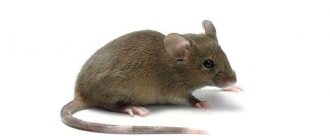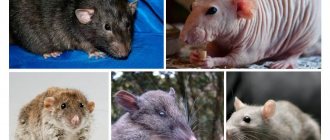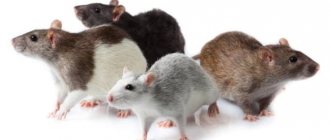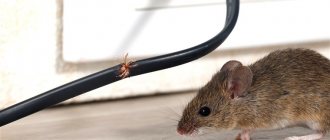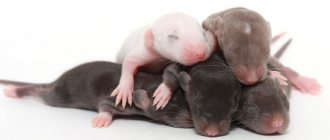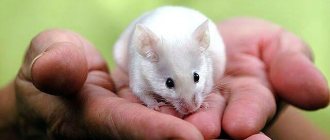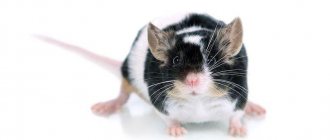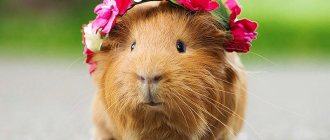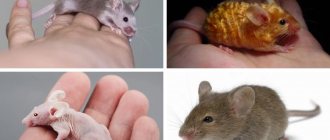There is practically not a single person who has not encountered mice or their cousins, rats, at least once in their life. Night rattles and rustling that prevent you from falling asleep, spoiled food, chewed furniture - all this indicates the appearance of unexpected guests in your home.
Some tirelessly fight with them, showing who is boss, while others, on the contrary, deliberately bring them into their homes, taming them and making them their favorites.
However, one should not ignore the fact that both mice and rats are the source of all sorts of dangerous diseases . Therefore, it is imperative to fight them. In order to choose the right method for getting rid of rodents, you need to know what their differences are.
And if in adults the difference is obvious - rats are much larger than mice, then what little rats and mice look like remains a question for many of us.
Appearance of little rats
Rats give birth to up to 15 cubs at a time. It’s worth paying tribute to, these animals make wonderful, caring mothers. From the moment the offspring are born until they reach the age of one month, the female is constantly with her babies. In addition to the fact that in the first days of life she serves as the only “feeder” for the rat pups, the mother constantly warms them with her body. Since there are quite a lot of babies, the rat takes turns moving them, changing places, so that everyone gets a piece of warmth. The body temperature of the cubs drops very quickly without the mother's body, which is why they can freeze and die.
Newborn rat pups are cute, defenseless creatures. They are born completely naked, without any signs of fur. Their eyes and ears are closed, but their sense of smell and instincts direct them to their mother's nipples with milk. The limbs are not yet fully formed, and the tail is very short; unlike adult rodents, the rat pups resemble small pink dolls with translucent pink skin and a large head.
Important! Immediately after birth, the babies should not be picked up, otherwise the female will abandon them or even eat them.
Interestingly, almost immediately after birth you can determine what the color of the rodent will be. Take a close look at the eyes. Although the baby is still completely blind and his eyeballs are covered with thin skin, through it you can see their color. If you notice black balls, it means the animal’s coat will also be dark. If the color of the eyes merges with the skin, the little rat will be light: white, beige or reddish.
The tiny body of a newborn rat pup weighs only about 4–6 g. It is already possible to tentatively guess the sex of the cubs based on their length. Males have a slightly larger body, can reach 9 cm, while females have no more than 6 cm.
Coat type
In addition to the standard gray rats with short shiny fur, there are unusual species of decorative rodents:
- Rex. These animals' fur is quite rough to the touch, curly and sticks out in different directions. Their distinctive feature is also their curled mustache and bushy tail.
- Velveteen. This type of rat has fairly soft fur, which lies in waves, but often looks disheveled.
- Fuzz. The body of these rodents is covered with white-gray down, which becomes longer and thicker on the face and stomach. Guard hairs are absent.
- Sphinx. The pink folded skin of the rat is devoid of fur. Individual fine hairs may be found on the abdomen and head.
- Double Rex. These rodents have hairless areas alternating with areas covered with hair.
There are also quite a lot of varieties of decorative rats that are not recognized by the international classification. But it is fair to note that this does not make them any less beloved by their owners.
I like it I don't like it
How baby rats grow day by day
Watching newborn rat pups for the first time, you will be extremely surprised at how quickly their development occurs. Unlike a person, who needs a fairly long period of time to become a more or less independent being, baby rats, already 4-5 weeks after birth, have the qualities of an adult. This is largely due to the quality of the female's milk, which contains up to 9% protein, 9.5% fat and about 4% lactose. By comparison, human milk contains only 1.5% protein, 3.2% fat and 6.5% lactose.
Did you know? Newborn rat pups have very weak intestines, which causes problems with bowel movements. The female gives them a stimulating massage, licking their bellies.
If we consider the development process of newborn rat pups day by day, it happens something like this:
- 1 day - all that the pink, well-fed caterpillars can do is actively search for the mother’s nipple and saturate the body with nutritious milk;
- Day 2 - babies continue to eat, sleep, and sometimes make a faint squeak;
- 4–5 days - by this time, a change in the color of the skin occurs, on which spots of the future color of the fur coat can be seen. By the way, there may even be small hairs all over the body. By the fifth day, the animals’ ears open, they can already hear everything that is happening around them;
- 8-10 days - babies are already quite active. Although the coordination of movements is not yet fully formed, they can already start fights for the mother's nipple. Sometimes it happens that with a large brood, the place at the “feeding trough” is occupied by stronger animals, and weak ones can simply die without food. To prevent this from happening, you need to move the saturated rat pups into a separate enclosure for a short time, giving the other kids the opportunity to drink milk. In this case, you should definitely wear medical gloves, and provide the displaced children with a warm heating pad. The baby's body is covered with neat soft fur;
- 12–14 days - by this age, the cubs are already teething, and many of their eyes are also opening. The appearance of an additional sensory organ makes rat pups more inquisitive. Now they can’t sit still - the animals are trying to explore everything that surrounds them. At the same time, the mother is constantly on alert, trying to gather the babies together;
- Day 16 - it is already possible to distinguish the sex of the pups, since the nipples of the females are clearly visible. Thanks to their already grown teeth, babies begin to actively try their mother’s food and not only it, but also any objects encountered along the way;
- 21 days - by the end of the third week, complementary foods can be introduced; some babies already manage to switch to adult food by this time, eating what is intended for their mother;
- Day 28 - by the end of the fourth week, you will already have fully formed baby rats. They feed on their own, and by this time the mother rat stops producing milk. Kids actively explore everything around them and happily make contact with people. It is interesting that in natural habitats, at the age of one month, a street rat pup is already capable of independently obtaining its own food and hunting.
How many days do it take for eyes to open?
Small rodents open their eyes around the end of the second week. For some it happens a few days earlier or later. The ability to not only sniff, but also examine the world around them makes babies even more active and inquisitive. They constantly strive to get out of the nest, but the caring female does not lose her vigilance, moving the cubs closer to herself.
The eyes of rats are slightly bulging and located on the sides of the head. This structure gives rats a large overview - the animals, without turning their heads, can see everything that is happening around them, as well as above and below. In this way, Mother Nature made sure that animals could see danger approaching them in time in the form of birds of prey and animals.
Who is better to have: a boy or a girl?
All decorative rats are sociable, unpretentious, smart and easy to train.
When choosing a pet, you should take into account its character and the temperament of the owner. Most boys are phlegmatic, most of the time they rest in their house, hammock or in the arms of their owner. They sleep much more often than girls, eat more, and move less.
From 6–8 months, boys experience hormonal changes. This is manifested by bursts of unreasonable aggression towards relatives and the owner. You need to be prepared for this. In addition, males mark territory and people for whom they feel sympathy. Their urine has an unpleasant, pungent odor that is difficult to get rid of. For this reason, their cage has to be cleaned more often than the females’ home.
Rat girls are more active and restless. They bite owners more often than boys. Pregnant or recently given birth females who protect their offspring are especially aggressive.
Female rats also mark their territory, but much less often than male rats. In addition, their urine does not have such a strong odor.
Rats of both sexes are more active at night and sleep during the day. Therefore, the owner must accustom them to their schedule: games in the evening, sleep at night.
Interesting! The activity of female rats depends on hormonal levels. They are almost constantly in heat; their estrus occurs at intervals of 5–10 days and lasts 14–24 hours.
Males get along better with other pets than females.
Experienced breeders strongly recommend keeping rats in groups (from 2 individuals). They need communication with their relatives for a full life and good health. Solitary confinement does not suit them.
How to care for baby rats
The total growth period for a rat is one year. During this time, the animal reaches the size of an adult: males weigh up to 600 g, and females - about 300 g. However, the foundation for full development is laid at a very early age. The cage with the female and newborn rats should be placed in the quietest and warmest room, where no one will disturb the family.
Don't worry about cleaning the nest - the mother rat will do it herself. You only need to periodically place new dry wipes in the cage, and the rat itself will throw dirty bedding into the corner. Only when the baby is 8–10 days old can you intervene in the cleaning process, carefully removing the waste material. This is only permissible if the female does not worry too much. Otherwise, cleaning should be postponed.
What do little rats eat?
The growth and development of cubs is largely influenced by the quality of nutrition. While staying near the mother for the first month, the basis of the diet is her milk. In order for it to be as beneficial as possible for babies, it is important to organize a balanced diet for the mother: in addition to the main food, the daily diet must include fruits, herbs, and animal food. Be sure to make sure that the female has enough water to drink - wash the drinking bowl and change the water daily.
Sometimes it happens that the female dies during childbirth, and if you cannot find her replacement (another nursing mother of a rat or mouse), you will have to do this yourself. Feeding newborn rat pups is not easy. For this purpose, dry infant soy formula, which is diluted with goat's milk, is best suited. Alternatively, you can use a pet milk replacer. Food is given to babies through a syringe. For convenience, you can equip it with a fabric pacifier.
Important! Little rats should not be given tomatoes, cucumbers and champignons, as well as any sweets.
In the first week you need to prepare the mixture as liquid as possible. Feedings are carried out every 2 hours during the day and a couple more times at night. In the second week, you can add ground grain feed to the mixture. Feeding periods are shortened - food is served every 4 hours. At week 3, the grain feed is simply mixed into the mixture and poured into a bowl. The cubs are already quite capable of eating it on their own.
By the end of the first month, a sufficient amount of protein should be present in the diet of rat pups, since a lack of this substance often leads to illness and mortality. The most useful additives: cottage cheese, boiled fish, apples, boiled chicken wings, egg yolks. Young rodents eat a lot: on average, their daily portion of grain is 80–100% of the weight of the animal itself.
Prevention
When a rat has no problems and is not sick, its eyes, nose and mucous membranes are absolutely clean. When there is porphyrin in your pet's nose (for no reason), your pet requires the attention of a specialist. At the veterinary clinic, they will take tests and examine the animal, as a result of which it will be possible to understand whether everything is normal or whether there is a disease. In the latter case, the doctor will prescribe treatment at home or prescribe procedures at a veterinary institution.
To prevent the animal from developing bad symptoms, the owner must follow the following rules:
- the cage with the pet should be located in a quiet, calm place - the animal needs comfort;
- The animal should not be stressed, make noise, shout or wake it up abruptly - this will scare it;
- the rat must be fed healthy and wholesome food;
- You constantly need to monitor your pet, its condition, skin and mucous membranes.
How long after birth can you pick up
Seeing small newborn lumps swarming around an adult female, you just want to pick them up or at least touch them. Under no circumstances should this be done. Firstly, their body is still very fragile and the slightest wrong movement or compression can lead to injury to the baby. Secondly, after you hold the baby in your hand, its coat will acquire a specific human smell. Mother rats often abandon such babies: they stop taking care of them, don’t feed them, and don’t keep them warm. The result is inevitable death. Despite all the caring behavior of females towards their offspring, they can kill a baby that emits an alien odor.
You will be interested to know what to do if decorative rats fight among themselves.
By three weeks, babies already look strong enough and can eat “adult” food. Even if the female does not want to accept a cub that smells like a human, it will be able to live and feed on its own. Experienced rat breeders recommend not delaying the taming of decorative rats. When the animal is a month old, it needs to be taken as often as possible, then the baby will be more obedient and affectionate.
Rats - popular Lariskas
Looking at photos of decorative rats, you understand that there is no single standard for determining the “breed”.
The ranking of the most popular of these decorative rodents includes:
- standard - large, smooth-haired animals with a tail equal to the size of the body. Reach up to half a kilogram of weight;
- satin - differ from their counterparts in soft long fur with a good shine;
- Dambo - round large ears and a sharp muzzle, a pear-shaped not very long body and an elongated tail;
- Sphynx - hairless individuals, may be born with age spots, but as adults the skin becomes pink;
- tailless - appeared in 1983 as a result of an unplanned mutation. Their body is shaped like a pear.
When can you give?
The minimum age at which a small rat can be transferred to other owners is 5-6 weeks. At this age, he is already completely independent, has all the necessary life skills. Until this time, the animal must stay with its mother as part of the brood, since under these conditions it will have to learn everything it will need in adult life, for example, to arrange a home and build a nest.
There is also no point in delaying the transfer of the animal to another owner. Firstly, even if you are not going to give away the babies, at the age of 5-6 weeks you will need, at a minimum, to seat the females and males in different houses, since they will already be ready for mating. Secondly, the younger the animal, the easier it gets used to its new owners. Relocation to a new home occurs with virtually no fear or stress for the animal.
Did you know? During a stressful situation, a baby rat is capable of producing a sound equal in volume to a working jackhammer, but due to the ultra-high frequency, a person cannot hear it.
What is porphyrin
Porphyrin also has a red-brown color, similar to blood. Such secretions are produced by the Harderian gland, which is located in the corners of the eyes, during stress, illness or pain. Porphyrin has the ability to bind metals. It performs certain functions in the rat’s body. First of all, it protects the eyes from light by lubricating the nictitating membranes. In bright light, this consistency is produced more actively. The Harderian glands are sensitive to ultraviolet rays and, under their influence, produce more porphyrin. This substance also signals the pet’s health status.
You should know that with age, the production of this consistency in this rodent increases. One-year-old specimens produce more porphyrin, even at the age of 3–4 months. But after 2 years, the amount of this consistency decreases, so when determining the normal volume of production of this substance, you need to take into account the age of the pet. Excess indicates problems in the animal’s body. In this case, it is better to take the rat to a veterinarian for examination.
Growth and development of babies
Little rats grow very quickly. In the first week of life, they gain 3 g of weight every day. Babies actively suck mother's milk, which has high nutritional value. It contains almost 9% protein, the same amount of fat and 4% lactose.
In the first days of their lives, rat pups are constantly near their mother. She moves them from place to place to warm everyone with her body. Small animals do nothing but eat and sleep. On the second day, hungry babies may begin to make a barely audible squeak. Approximately 4 days after birth, the ears of rat pups rise. Now they can hear.
Already on the 4-5th day of life, you can determine what color the little rat pups will have. In light-colored rat pups, the skin remains pink, while in dark-colored pups, it acquires a grayish tint. During this period, the first soft fluff appears on the body.
At the age of one week, baby rats' incisors begin to emerge. The molars will appear no earlier than in 3 weeks. In some individuals they grow only on the 35-40th day of life.
The rate of tooth growth depends on the individual characteristics of the animal and diet.
One of the most significant periods in the life of little rats is the time when their eyes open. This occurs 14-17 days after birth. At first a small gap appears between the eyelids, but after a couple of days the babies begin to see.
From this moment on, the little rats become more active and begin to crawl out of the nest. They look around with great curiosity, go around every corner of the cage, learn to wash themselves and clean their fur. By the way, by this time it has already completely grown back. Between the 15th and 20th days of life, females develop nipples.
At 3 weeks of age, the pups look like their adult counterparts. Their body length reaches 14-15 cm, but the tail is still short. At 25 days the animals become completely independent. Females are already capable of becoming pregnant, but this is undesirable, since the body is not yet fully formed and strengthened. The development of rat pups continues until they are one year old.
Physiological features
It is important to first address the physiology aspect. Many have already read articles about mice and roughly understand the characteristic features of a rodent
The information obtained is not always enough to make a final verdict on the situation. In addition to photographs, we suggest studying several fundamental aspects for successful pest identification:
- Body length. Rats are significantly larger than mice and reach a body length of up to 30 cm. Such pests are more muscular and look especially massive compared to fragile mice. There are also individual specimens of mice where the differences are not particularly noticeable, but this happens extremely rarely;
- Muzzle. Rats have a more elongated skull, so their eyes stand out as much as possible. Mice are characterized by a somewhat flattened muzzle shape;
- Tail. This part of the body in rats is completely naked and significantly thickened at the base. The tail of mice is slightly smaller and matches the color of the fur on the body;
- Weight. The difference is especially noticeable when comparing weight, since female rats sometimes grow up to 900 g, and mice rarely exceed 50 g of both weights;
- Ears. Rats are endowed with much smaller ears, tightly pressed to the head, while mice have ears that are quite wide.
Pay attention to the structure of the coat, as in large rodents it is stiffer and denser. In general, there are a number of obvious signs that make it difficult to confuse two rodents
If you don’t know how to distinguish a mouse from a baby rat, then pay attention to the characteristic body structure in the proportional ratio of the sizes of the ears and tail.
Life of rodents
They do not dig holes in the ground, but build nests in trees. A rat's building is similar to a magpie's nest. There are often cases when animals move into a ready-made nest, having first eaten its inhabitants.
Excellent climbing abilities allow black rats to move freely on both horizontal and vertical surfaces. The animals are able to climb to the very top of the tree, but they climb so high only when absolutely necessary.
During the day, black rats sit at home, hiding from sunlight, and under the cover of night they go in search of food.
Caution is the key to any activity for a rodent. This is due to the large number of predatory enemies - animals with dark fur coats are eaten:
- birds;
- cats;
- dogs;
- hedgehogs;
- foxes;
- wolves.
The average lifespan of a wild rodent is 1-1.5 years. A decorative black rat kept as a pet can live for 4 years.
Differences in behavior
If the pests were not caught red-handed, their presence can be determined by evidence. What is the difference between a mouse and a rat - the most important points.
Traces of a break-in
It is necessary to inspect the sites of sabotage. Rats are carnivores by nature. They prefer meat, lard, smoked meats, and carry bread, sausage, and cookies. They chew hard objects, preferring wood. They easily gnaw electrical wires and cords. They live near food waste and garbage cans.
Mice prefer grains, flour, sugar, cereals, and occasionally eat meat products. They leave behind damaged bags, plastic bags, newspapers, books, and leather goods. You can distinguish by these signs.
Footprints
They can freely talk about a pest that secretly hunts in the dark. The mouse leaves behind a chain of small steps located in close proximity to each other. The animal climbs well on shelves, window sills, cabinets, and rarely jumps. Mouse tracks in the snow are very clearly visible.
The rat moves with confident, long steps. If necessary, it can jump up to 1.5 m in height and up to 2 m in length. By this sign you can recognize the pest.
The footprints in the snow of a rat and a mouse are different: the former have round paw prints, while the rats have long ones.
On a note!
Rats rarely crawl into the house; they prefer outbuildings, cellars, warehouses, barns, sheds, and poultry houses. Don't mind eating chicken or gnawing on a pig's ears. Every farmer dreams of getting rid of rats in a chicken coop or barn. It can drag away a small puppy or kitten. If it enters a house, it usually hides under the floor. Mice love to live in human homes. They live in walls with insulation, under the floor, in the attic. At night you can often hear rustling sounds and the movement of small paws.
The rats and mice in the photo with the ability to perform various tricks are presented below.
What to feed a mouse
Ornamental mice feed mainly on grain mixtures, including seeds of herbaceous plants such as wheat, oats, peas, barley, cake, millet, sunflower seeds, and flax. Can be supplemented with nuts.
Oilseeds should be present in an amount of no more than twenty percent of the mixture in summer and thirty in winter, otherwise the risk of obesity is high. Too much legume seeds can also lead to obesity, although their presence in the diet is desirable. Mice can be pampered with berries, fruits, especially apples, dried fruits, carrots, cabbage, potatoes, beets and cucumbers. In addition to all of the above, feeding mice porridge is common. Oatmeal, rice and millet porridge are suitable
It is important that the porridge is cool and contains grains that have been previously cleared of impurities
It is vital for mice to have their incisors ground down from time to time. Small branches of trees and shrubs are well suited for this purpose, the main thing is that they contain bark. Almost all plants are suitable for this, except lilacs and conifers.
If preparing food yourself is difficult, then pet stores sell ready-made mixtures and other nutritional components for mice.
Methods of disposal
To prevent the settlement of large colonies of rodents, it is necessary to promptly remove garbage and plant remains from the area.
It is advisable to dig up the soil by the time autumn approaches. If mice have already settled on the site, then in order to rid your home and storage areas of these rodents, you can go in two ways. The first of them is more humane and is based on the intolerance of some odors by these mice. If you place some plants in the pest holes, you can survive the small pests without harming them. Such plants are:
- elder;
- garlic;
- mint;
- sagebrush;
- black root;
- imperial hazel grouse.
You can also use chemicals, such as kerosene or ammonia. They should not be poured into the hole from the bottle. Simply soak a piece of cotton wool in the liquid and place it in the rodent’s home. He will leave him and never return.
If humane methods for one reason or another do not bring the desired result, then you can take a more cruel route, using resources such as:
- mousetraps;
- ultrasonic repellent devices;
- I;
- ash;
- cats.
Mousetraps and cats are commonplace, but this cannot be said about ultrasonic repellers. They can be easily purchased in specialized stores. The principle of operation is to produce sounds that are inaudible to humans, but painful to the sensitive ears of rodents. The voles will not be able to tolerate it and will leave the area. For certain reasons, they also try to avoid ash.
The field mouse is quite cute in appearance, you can see this just by looking at its photo. But its pleasant appearance absolutely does not justify the irreparable harm it causes to agriculture. Therefore, one cannot but rejoice at the fact that although it appears easily, getting rid of it will not be particularly difficult.
A real homebody
Over the entire history of living next to humans, rats have made dizzying journeys - they populated almost the entire planet on ships and trains. But biologists still say: they are homebodies.
No, sometimes they get the wanderlust itch. For example, in 1966, hundreds of thousands of rats in Thailand, for no apparent reason, walked around the country en masse and swam across rivers. But, as they say, the exception only confirms the rule.
In Soviet times, one scientist marked black rats living in the Abkhazian forest. Two months of surveillance showed that the rats did not dare move even fifty meters away from the nest.
The gray rats that were spied on in Volgograd were a little bolder - they could break away from their home by 100-120 meters. But with a sufficient amount of food, they staunchly adhere to their habitable place. In general, home sweet home.
Rat.
creativecommons.org

